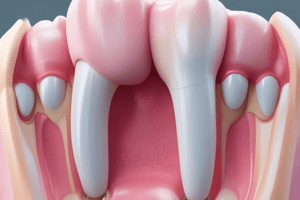Podcast
Questions and Answers
Resin Modified Glass Ionomer Cement releases fluorides gradually.
Resin Modified Glass Ionomer Cement releases fluorides gradually.
True (A)
Polyacid Modified Composite Cement primarily used in adult dentistry.
Polyacid Modified Composite Cement primarily used in adult dentistry.
False (B)
Bioceramic Luting Cement is water-based and contains calcium sulfate components.
Bioceramic Luting Cement is water-based and contains calcium sulfate components.
False (B)
Dental cements are crucial for maintaining the integrity of dental restorations.
Dental cements are crucial for maintaining the integrity of dental restorations.
Temporary Restorations are used when permanent restorations are not available.
Temporary Restorations are used when permanent restorations are not available.
Cavity Linings are used to speed up the damage process of the tooth structure.
Cavity Linings are used to speed up the damage process of the tooth structure.
Zinc Phosphate Cement is a resorbable material.
Zinc Phosphate Cement is a resorbable material.
Polycarboxylate Cement has a rapid setting speed.
Polycarboxylate Cement has a rapid setting speed.
Glass Ionomer Luting Cement contains zinc and phosphate elements.
Glass Ionomer Luting Cement contains zinc and phosphate elements.
Zinc Phosphate Cement is commonly used for temporary restorations.
Zinc Phosphate Cement is commonly used for temporary restorations.
Polycarboxylate Cement induces a severe inflammation response when used.
Polycarboxylate Cement induces a severe inflammation response when used.
Glass Ionomer Luting Cement is not involved in releasing any fluorides.
Glass Ionomer Luting Cement is not involved in releasing any fluorides.
Flashcards are hidden until you start studying
Study Notes
Dental Cements: Understanding Types and Applications
Overview
Dental cements play a crucial role in securing restorations in place. They are used to fix dental crowns, inlays, onlays, and fixed bridges onto teeth. These materials are chosen based on their compatibility with the restoration material and the individual patient's needs. Dental cements have evolved significantly over the years, offering a range of properties to enhance durability, aesthetics, and biocompatibility.
Types of Dental Cements
-
Zinc Phosphate Cement
- Contains zinc and phosphate elements.
- Traditional choice for crown and bridge cementation.
- Non-resorbable, can be used as a final or temporary cement.
- Radiopaque, meaning it shows up on X-rays.
- Has moderate thermal conductivity.
- Used for routine luting of metal-supported crowns and bridges, as well as temporary restorations.
- Often requires removal prior to placing a final restoration.
-
Polycarboxylate Cement
- Also known as zinc poly-acrylate cement.
- Induces a mild inflammation response when used.
- Very strong bond to tooth structure.
- Difficult to remove once set.
- Rapid setting speed, leading to complex mixing and handling.
- Used for filling materials, protecting cavity liners, and creating luting materials for crowns, bridges, inlays, and orthodontic appliances.
-
Glass Ionomer Luting Cement
- Silicate glass powder combined with a polyacrylic acid liquid.
- Releases fluorides, contributing to tooth protection.
- Good adhesion to enamel and dentin.
- Acidic nature.
- Used for abrasion and erosion of cavities, restoration of deciduous teeth, restoring class III and class V carious lesions, and tunnel restorations.
-
Polyacid Modified Composite Cement
- High bond strengths to the oral cavity.
- Low solubility in oral fluids.
- Loses bond strength over time due to moisture absorption.
- Primarily used in children's dentistry.
-
Resin Modified Glass Ionomer Cement
- Hydrophilic property, making it resistant to moisture.
- Releases fluorides gradually.
- Used for Class I, Class II, Class III, and Class V restorations in primary teeth.
-
Resin Based Cement
- Can be exclusively cured with a dental curing light.
- Builds high bond strength to the tooth structure.
- Low strength dental ceramics.
- Not radiopaque.
- Specifically used in restorative dentistry.
-
Bioceramic Luting Cement
- Water-based, containing calcium aluminate and glass ionomer components.
- Gains traction rapidly.
- Used in endodontics, implant dentistry, orthodontics, and other applications.
Applications in Dentistry
Dental cements are used in various dental procedures, such as:
- Temporary Restorations: Provisionally securing restorations until a permanent one is ready.
- Luting Agents: Bonding crowns, bridges, inlays, onlays, and orthodontic appliances to teeth.
- Cavity Linings: Protecting the tooth structure from further damage.
- Root Canal Fillings: Sealing the tooth after root canal treatment.
- Pulp Capping: Preserving the pulp of damaged teeth.
In conclusion, dental cements are essential for maintaining the integrity of dental restorations. Different types of cements are chosen based on their compatibility with the restoration material, ease of use, and the specific needs of the patient. Understanding the properties and applications of these cements helps dental professionals to select the most suitable material for each patient's individual situation.
Studying That Suits You
Use AI to generate personalized quizzes and flashcards to suit your learning preferences.




